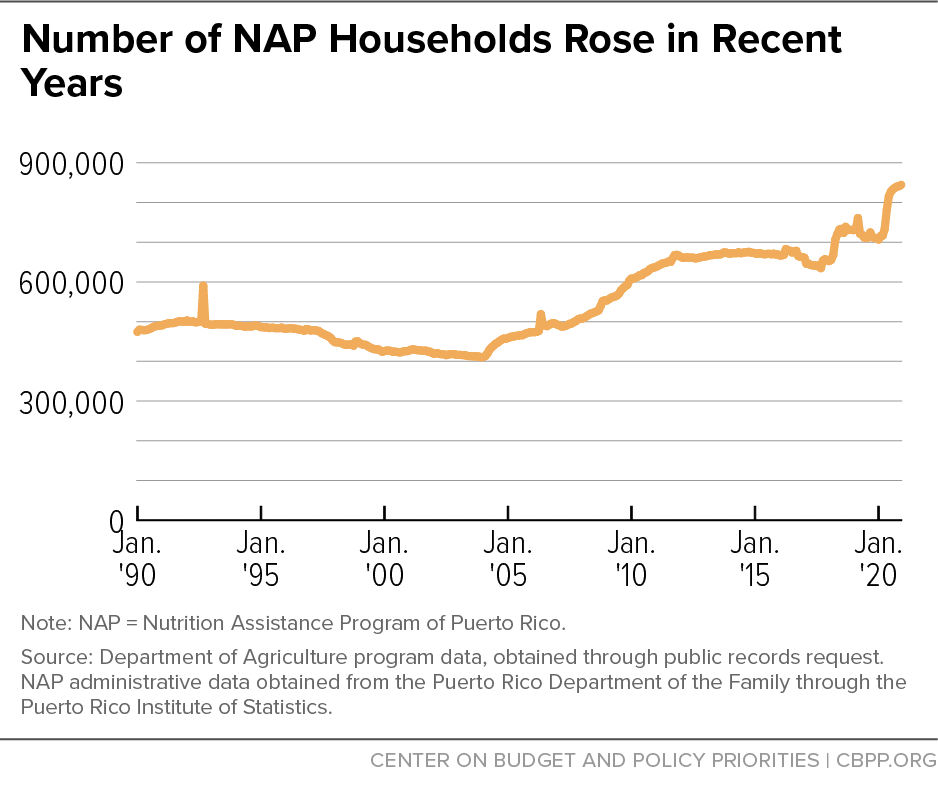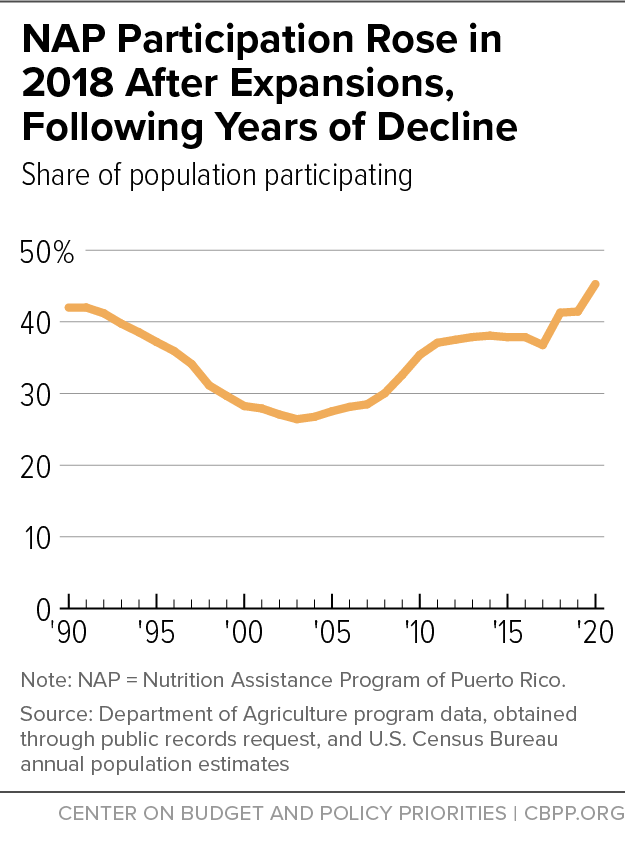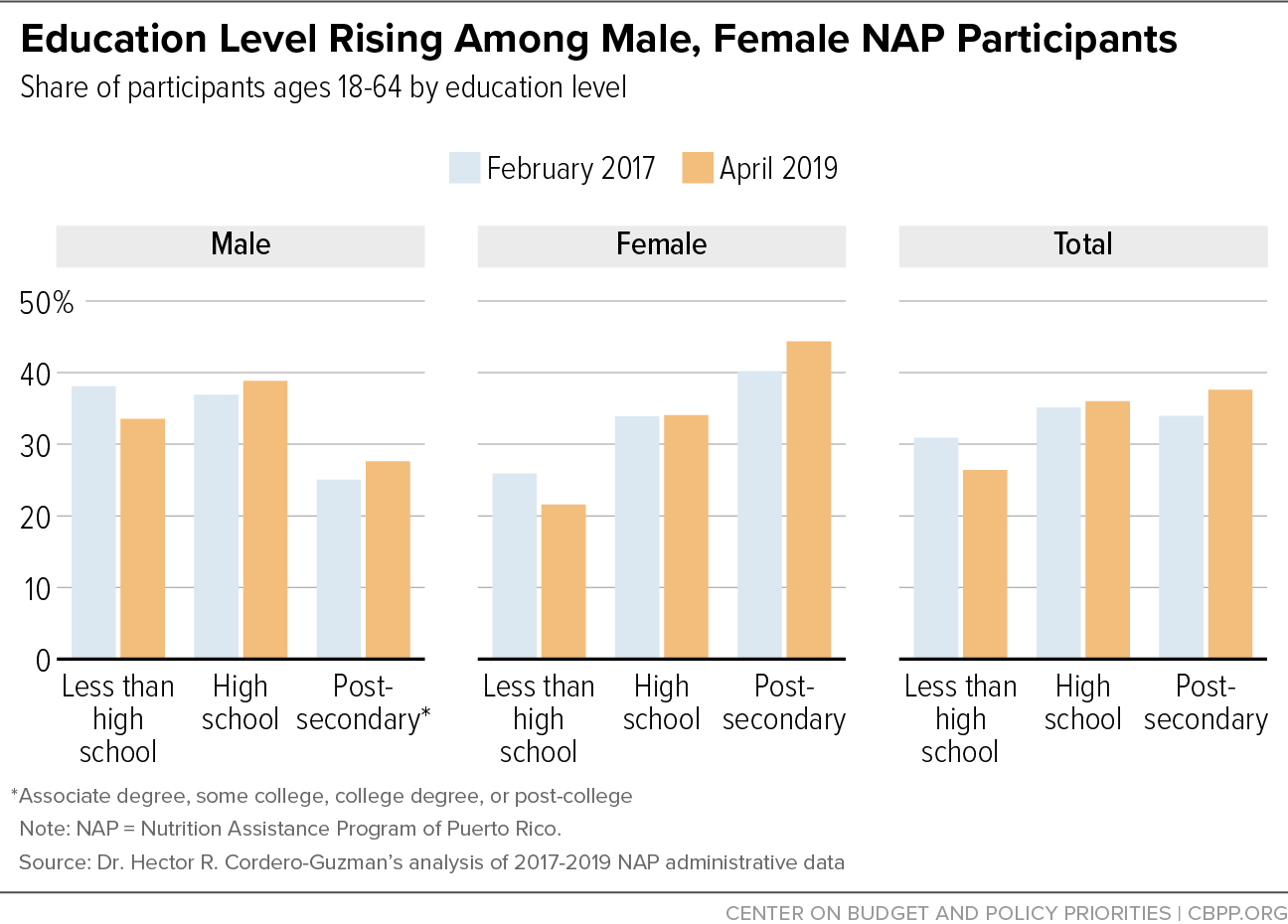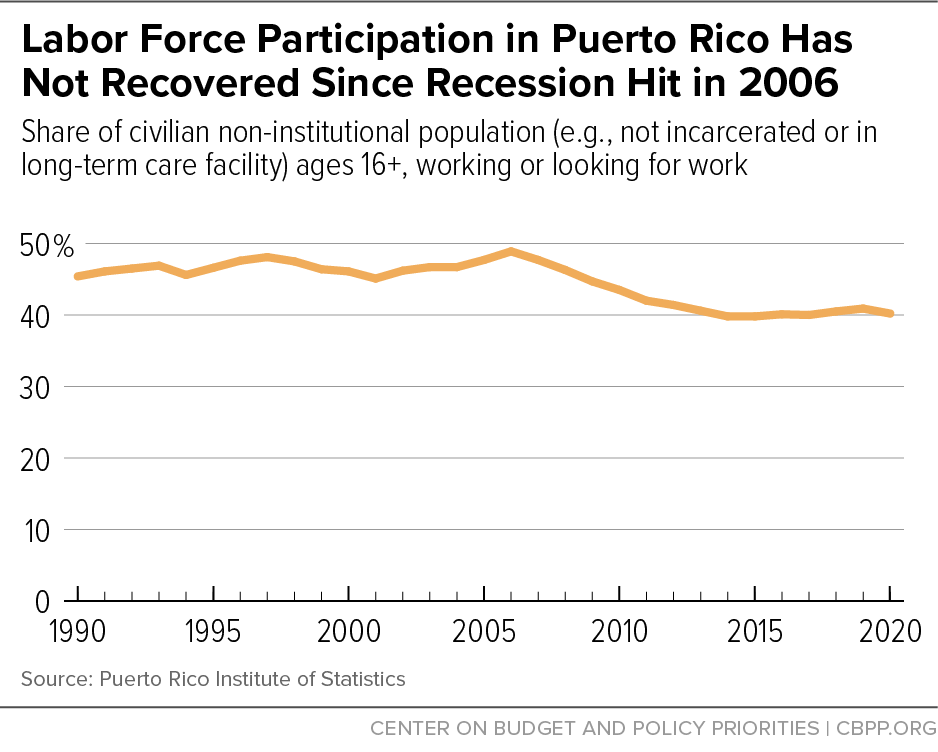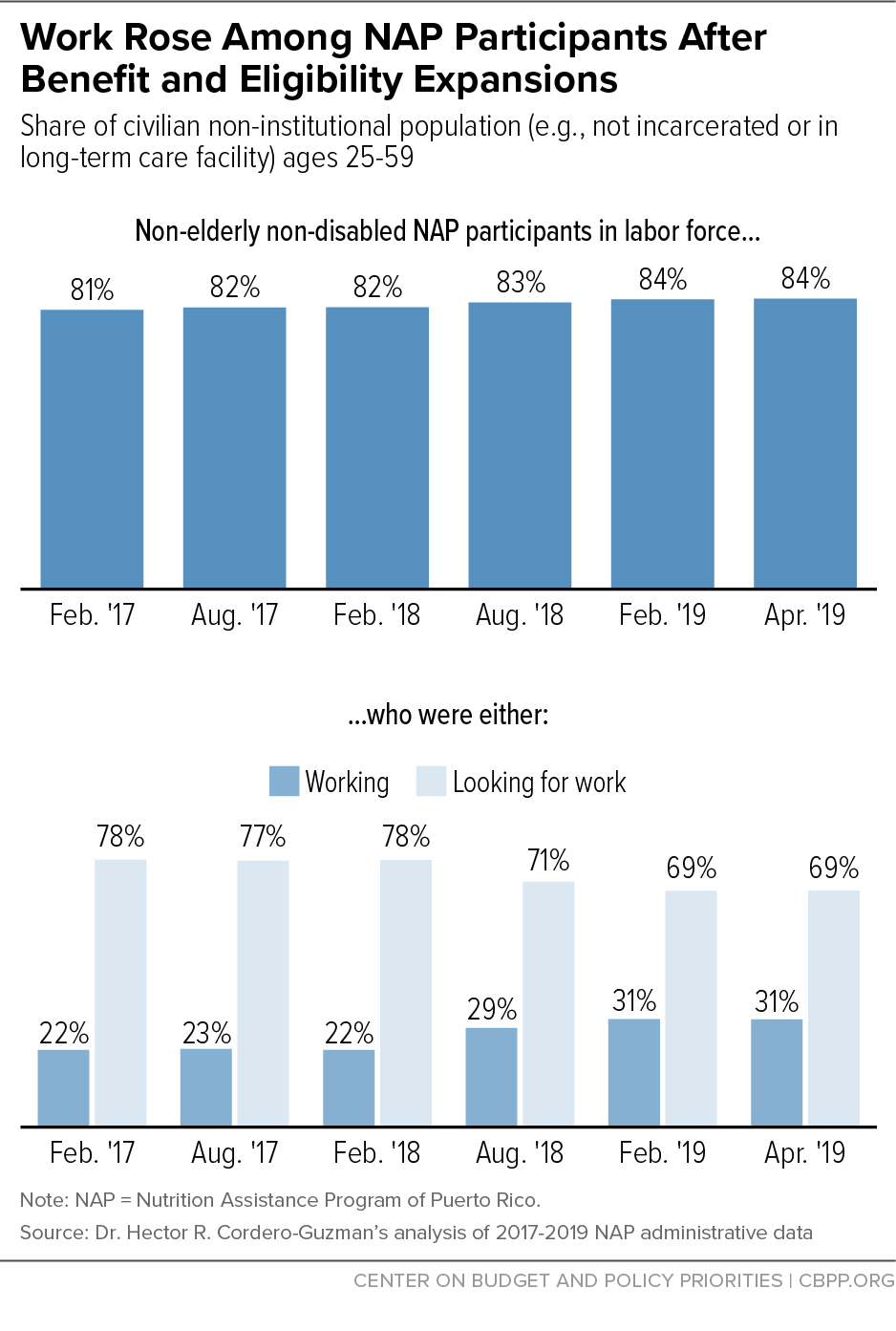Debates in Puerto Rico about the impact of economic security programs — particularly the Nutrition Assistance Program (NAP, or PAN for Programa de Asistencia Nutricional) — on participants’ employment status, family incomes, and the well-being of the overall population have been taking place since the 1974 introduction of NAP’s predecessor, the Food Stamp Program, but have heightened since the devastating 2017 Hurricanes Irma and Maria. This study analyzes NAP administrative data for 2017 through early 2019, during which supplemental federal funding to aid in recovery from the hurricanes enabled NAP to raise benefits and eligibility limits, to answer three interrelated questions: 1) What were the main socioeconomic characteristics of NAP participants? 2) Did these characteristics change significantly over the period? 3) In particular, did adult participants’ connections to the labor market and work status change over the period?
An analysis of changes in overall NAP participation and NAP participants’ demographic characteristics and employment finds:
- Several demographic characteristics remained stable over the 2017-2019 period, such as composition by gender and disability, but some shifts occurred, with shares decreasing for children and increasing for elderly individuals. Those shifts were consistent with changes in these subgroups among the broader population.
- About one-third of participants had post-secondary education, with rates higher among women, and this share increased over time.
- The share of participants who were participating in the labor force (that is, working or looking for work) and the share reporting employment rose in this period.
Puerto Rico began participating in the federal Food Stamp Program beginning in 1974, but federal policymakers replaced it with a block grant called the Nutrition Assistance Program (NAP) in 1982 and cut funding significantly. Because NAP is funded through a block grant with fixed federal funding, funding constrains program decisions about eligibility and benefit levels, and the program has limited capacity to expand to meet increased need; historically, NAP has accommodated an increase in participation only by keeping benefit levels low. Likely due to limited funding, very low and fixed income eligibility limits, and other factors, NAP participation fell during the 1990s (the earliest available data), reaching a low point in terms of participation and share of the population served in 2002-2004. The number of households participating in NAP rose somewhat in the years following the onset of a recession in 2006,[2] continued rising more sharply after NAP received temporary funding in response to the Great Recession of 2007-2009 (which allowed the program to expand more), then fell somewhat over 2012-2017, likely due to in part to the expiration of those temporary funds.[3] (See Figure 1.)
Puerto Rico’s economy has been in a virtually uninterrupted decline since 2006, and one impact has been substantial outmigration, with the population shrinking by over 500,000 (about 15 percent) between 2006 and 2019, from 3.8 million to 3.2 million.[4] The 2017 hurricanes accelerated outmigration (though it appears to have slowed in recent years)[5] and added to Puerto Rico’s economic woes.
Following the hurricanes, federal policymakers enacted two relief bills to supplement NAP. Because NAP is a block grant, policymakers must enact legislation to increase funding when need expands, such as following a natural disaster.
The first supplemental package, in place from March 2018 to February 2019, provided $1.2 billion, which Puerto Rico used to raise monthly benefits and income eligibility limits. (This funding represented a significant supplement to the regular block grant funding level of about $1.9 billion.) For example, under regular NAP rules, a family of three qualified for the program if its monthly net income (income after some deductions and exclusions are applied) was below $599 and received a maximum monthly base benefit of $315; under the disaster funding, a family of three qualified if its income was below $1,606 and received a maximum base benefit of $511, the same maximum benefit level used in the Supplemental Nutrition Assistance Program (SNAP), the food assistance program available in the states and some territories.[6] When this supplemental funding expired in March 2019, benefits reverted to previous levels, but the Commonwealth maintained the higher eligibility limits (which remain in effect).[7]
This analysis focuses on the period from directly before the hurricanes to the end of the first supplemental funding package, from February 2017 to April 2019. This funding allowed NAP to respond more adequately to increased need than it had in the past, by expanding both benefits and eligibility. NAP participation rose substantially in 2018 following those expansions, then leveled off in 2019 after the benefit expansion ended. More specifically, the number of participating households:
- Fell by about 5,000 (1 percent) between February 2017 and February 2018;
- Rose by almost 90,000 (14 percent) between February 2018 and February 2019; and
- Fell by about 11,000 (about 2 percent) between February 2019 and April 2019, the most recent month for which we have detailed data. Overall, the number of households increased by about 12 percent over this period.
Other program data also show a continued modest decline in participation from April through December 2019. The number of participating NAP households rose sharply in 2020 due to the COVID-19 crisis.[8]
Measured as a share of the population, NAP participation, which started growing in the mid-2000s after about a decade of decline, stayed fairly steady between 2012 and 2016 despite little change in the number of participating households, because the Commonwealth’s population fell due to outmigration, lower birth rates, and higher mortality.[9] Participation rose in 2018 and continued growing into 2019, due both to the significant population decline after the hurricanes[10] and to increases in the number of participants, particularly after enactment of supplemental funding. (See Figure 2.)
Focusing on the period immediately preceding and following the receipt of supplemental funding, some key demographic characteristics of adult NAP participants remained stable between February 2017 and February 2019, while others changed slightly:
- Gender. The gender composition of participants remained relatively stable, with about 57 percent classified as female and 43 percent as male.
- Age. Consistent with changes in Puerto Rico’s overall population, the share of participants under age 17 fell from 27 percent to 25 percent, while the share over age 65 rose from 17 percent to 19 percent. (The share between ages 18 and 64 remained relatively stable.) Put another way, about 1 in 4 participants were under 18, 2 in 4 were 18-59, and 1 in 4 were over 60.
- Disability. The share of participants with a disability remained stable at about 18 percent. Among participants under age 60, about 11 percent had a documented disability.
- Homelessness. The share of participants classified as homeless remained stable at under 1 percent, or roughly 1,600 to 1,700 individuals.
- Students. The share of participants classified as K-12 students remained stable at around 18-19 percent.
- Workers. The share of participants classified as workers, meaning they reported some salary, remained relatively stable in the period before the supplemental funding (February 2017 to February 2018) at around 11 percent or 130,000 individuals. Worker participation rose significantly after the increased eligibility limits and benefits took effect in March 2018, to about 14 percent (192,000), then declined slightly after the supplemental funding that had supported those increases expired. The share of NAP households with a member reporting a salary also increased significantly, from about 18 percent in February 2017 to 24 percent by February 2019, then leveled off.
- Sources of income. Consistent with the increase in the share of participants over age 65, the share of participants receiving some form of Social Security rose from about 29 percent in February 2017 to 31 percent in April 2019. In addition, the share of households reporting having some “other form of income” fell from 25 percent in August 2018 to about 22 percent in February 2019; this small drop may be related to the significant increase in the share of households with salaries.
Over one-third of NAP participants have some post-secondary education, a share that’s grown over time and is higher among female participants. (See Figure 3 and Table 2.)
Between February 2017 and April 2019, the share of participants that had not graduated from high school fell from 31 percent to 27 percent, while the share with an associate degree, some college, or a college degree or more education rose from 34 percent to 38 percent. The share with a high school degree remained relatively stable at about 36 percent. These changes could reflect several factors, such as increasing educational attainment among Puerto Rico’s younger population and more participants with higher levels of education being eligible and entering the program.
Educational attainment grew among both male and female participants in this period but remained much higher among women. The share of men with less than a high school degree fell from 38 percent to 34 percent; among women, the share fell from 26 percent to 22 percent. That is a 12 percentage point difference between men and women. Similarly, the share with postsecondary education (an associate degree, some college, or completed college or more) rose for both male and female participants but remained much higher among females. Between February 2017 and April 2019, it rose from about 25 percent to 27 percent among male participants and from about 40 percent to 44 percent among female participants. This means that slightly fewer than half of the women in the NAP program have some post-secondary education.
It is important to note that the share of NAP participants who did not complete high school (27 percent) is smaller than the shares who have a high school degree (36 percent) or have attended college, received an associate degree, or completed college or more (38 percent). The share of participants not completing high school, however, is still high compared to the overall population (22 percent).[11] On the other hand, consistent with continued increases in educational attainment on the island, younger cohorts of NAP participants have significantly higher education than those over age 45.
Historically, Puerto Rico has had high unemployment rates and low employment levels and labor force participation rates. As Figure 4 shows, the labor force participation rate fell from about 48 percent when the 2006 recession began to about 40 percent in 2013, had barely improved by 2017 when the hurricanes ravaged the island, and remained flat through 2019, before the COVID-19 economic crisis.
Among NAP participants, employment status and labor force participation remained relatively stable between February 2017 and February 2018 (right before the supplemental funding took effect), despite the hurricanes. Labor force participation among NAP participants then rose and unemployment fell among these individuals between 2018 and 2019, when the supplemental NAP funding was in effect:
- Among participants ages 25-59 without a documented disability, the share who were in the labor force rose from 82 percent in February 2018 to 84 percent in February 2019 and stayed at that level through April 2019, the latest month for which data are available. Meanwhile, the share not in the labor force fell from 18 percent to 16 percent.
- For those in the labor force, the share who were employed rose from 22 percent in February 2018 to 31 percent by February 2019 and stayed at that level through April 2019, the last month for which we have detailed data. The bulk of the increases in employment for the February 2017-February 2019 period occurred between February 2018 and August 2018, when the supplemental funding began. During those months, the share of NAP participants ages 25-59 without a documented disability who were employed jumped from 22 percent to 29 percent. (See Figure 5.)
While higher shares of male NAP participants were in the labor force and employed than female participants, these gaps narrowed over the February 2017-April 2019 period, as the gains in these areas were more pronounced among women. (See Table 3.) Labor force participation among female NAP participants ages 25-59 without disabilities rose from 75 percent to 77 percent between February 2017 and February 2018, then to 79 percent in August 2018 and 80 percent in February 2019, staying at that level through April 2019. The share of female NAP participants who were employed rose even more: from 21 percent in February 2017 through February 2018 to 28 percent in August 2018 and 31 percent in February 2019, staying there through April 2019.
For male NAP participants, labor force participation remained high over this period and the share who were employed rose. In February 2017 about 91 percent of male NAP participants ages 25-59 without disabilities were in the labor force and about 9 percent not in the labor force; these shares stayed the same through April 2019. In contrast, the share of male NAP participants who were employed remained at 24 percent from February 2017 through February 2018 but then rose to 29 percent in August 2018 and 32 percent in February 2019, staying there through April 2019.
To the extent that the increase in the share of NAP participants who are working represents a trend, there are several potential factors that could contribute to this modest increase. The benefit increase from the supplemental funding may have enabled more participants, particularly women with children, to take a job outside the home by helping them afford transportation, child care, and other work-related costs. The higher eligibility limits may have allowed some participants to seek and sustain more formal employment outside the home without risking or jeopardizing their access to needed nutritional assistance benefits for their family. Also, the households entering the program after March 2018 (that is, after the income eligibility limits were increased) may have been more likely to include workers, who previously would not have been eligible.
The increase in employment among NAP participants is of particular note given proposals to take NAP benefits away from participants who aren’t working a set number of hours per month. Each year since 2018, for example, the fiscal plans certified by the federally mandated Financial Oversight and Management Board for Puerto Rico (FOMBPR) have called for such a proposal in NAP in Puerto Rico.[12]
The employment increases documented here occurred without such harsh policies, which in other programs have not substantially improved employment and have caused many individuals to lose access to benefits.[13]
| TABLE 1 |
|---|
|
| | Feb-17 Number (000) | Share | Aug-17 Number (000) | Share | Feb-18 Number (000) | Share | Aug-18 Number (000) | Share | Feb-19
Number (000) | Share | Apr-19 Number (000) | Share |
|---|
| Households | 646 | | 642 | | 640 | | 708 | | 730 | | 719 | |
| Participants | 1227 | | 1211 | | 1189 | | 1316 | | 1347 | | 1320 | |
| Female | 693 | 56% | 685 | 57% | 672 | 57% | 747 | 57% | 769 | 57% | 754 | 57% |
| Male | 534 | 44% | 526 | 43% | 517 | 43% | 569 | 43% | 578 | 43% | 566 | 43% |
| 0-17 | 330 | 27% | 322 | 27% | 304 | 26% | 334 | 25% | 334 | 25% | 326 | 25% |
| 18-24 | 136 | 11% | 133 | 11% | 130 | 11% | 140 | 11% | 141 | 10% | 136 | 10% |
| 25-44 | 276 | 22% | 271 | 22% | 270 | 23% | 303 | 23% | 305 | 23% | 296 | 22% |
| 45-59 | 206 | 17% | 203 | 17% | 203 | 17% | 230 | 17% | 235 | 17% | 230 | 17% |
| 60-64 | 69 | 6% | 68 | 6% | 69 | 6% | 78 | 6% | 83 | 6% | 82 | 6% |
| 65+ | 211 | 17% | 213 | 18% | 214 | 18% | 232 | 18% | 249 | 19% | 250 | 19% |
| Has disability, under 60 | 108 | 11% | 104 | 11% | 100 | 11% | 111 | 11% | 110 | 11% | 109 | 11% |
| Homeless | 2 | 0% | 2 | 0% | 2 | 0% | 2 | 0% | 2 | 0% | 2 | 0% |
| Student1 | 232 | 19% | 226 | 19% | 214 | 18% | 239 | 18% | 245 | 18% | 240 | 18% |
| Worker | 132 | 11% | 131 | 11% | 128 | 11% | 173 | 13% | 192 | 14% | 189 | 14% |
| Households with salary earner | 117 | 18% | 117 | 18% | 113 | 18% | 154 | 22% | 175 | 24% | 172 | 24% |
| Participant receives Social Security | 351 | 29% | 348 | 29% | 342 | 29% | 382 | 29% | 407 | 30% | 407 | 31% |
| Participant in household with individual receiving other income | 302 | 25% | 300 | 25% | 289 | 24% | 326 | 25% | 299 | 22% | 292 | 22% |
| TABLE 2 |
|---|
|
| | Feb-17 | Aug-17 | Feb-18 | Aug-18 | Feb-19 | Apr-19 |
|---|
| Male |
| Completed Elementary | 18% | 18% | 17% | 16% | 15% | 16% |
| High School-No Degree | 20% | 20% | 20% | 19% | 18% | 18% |
| High School Graduate | 37% | 37% | 37% | 38% | 39% | 39% |
| Associate Degree or Some College | 23% | 23% | 23% | 24% | 24% | 24% |
| College Degree or more | 2% | 2% | 3% | 3% | 3% | 3% |
| Female |
| Completed Elementary | 11% | 10% | 10% | 9% | 9% | 9% |
| High School-No Degree | 15% | 15% | 15% | 14% | 13% | 13% |
| High School Graduate | 34% | 34% | 34% | 34% | 34% | 34% |
| Associate Degree or Some College | 35% | 36% | 36% | 36% | 37% | 37% |
| College Degree or more | 5% | 5% | 6% | 7% | 8% | 7% |
| Total |
| Completed Elementary | 14% | 13% | 13% | 12% | 11% | 12% |
| High School-No Degree | 17% | 17% | 17% | 16% | 15% | 15% |
| High School Graduate | 35% | 35% | 35% | 35% | 36% | 36% |
| Associate Degree or Some College | 30% | 30% | 30% | 31% | 32% | 32% |
| College Degree or more | 4% | 4% | 4% | 6% | 6% | 6% |
| TABLE 3 |
|---|
|
| | Feb-17 | Aug-17 | Feb-18 | Aug-18 | Feb-19 | Apr-19 |
|---|
| Non-elderly, non-disabled adults |
| In Labor Force | 81% | 82% | 82% | 83% | 84% | 84% |
| Working | 22% | 23% | 22% | 29% | 31% | 31% |
| Unemployed | 78% | 77% | 78% | 71% | 69% | 69% |
| Not in Labor Force | 19% | 18% | 18% | 17% | 16% | 16% |
| Female non-elderly, non-disabled adults |
| In Labor Force | 75% | 76% | 77% | 79% | 80% | 80% |
| Working | 21% | 21% | 21% | 28% | 31% | 31% |
| Unemployed | 79% | 79% | 79% | 72% | 69% | 69% |
| Not in Labor Force | 25% | 24% | 23% | 21% | 20% | 20% |
| Male non-elderly, non-disabled adults |
| In Labor Force | 91% | 91% | 91% | 91% | 91% | 91% |
| Working | 24% | 24% | 24% | 29% | 32% | 32% |
| Unemployed | 76% | 76% | 76% | 71% | 68% | 68% |
| Not in Labor Force | 9% | 9% | 9% | 9% | 9% | 9% |
The author obtained public use, de-identified NAP/PAN administrative data from the Puerto Rico Department of Family through a public records request to the Puerto Rico Institute of Statistics for this analysis.
Table 1: The indicators include the number of households participating in the program in selected months, number of participants, gender composition of the caseload, and age distribution. Other indicators include the number of cases with a verified disability under age 60, number of cases that report being homeless, number of students in the program, number of workers (defined as persons reporting positive earnings), number of households with at least one member earning a salary, number of participants receiving Social Security, and number of participants in households that report some “other income.”
Table 2: The table includes information on the last year of schooling completed and is divided into the following categories: participants who attended elementary and intermediate school; those who attended high school but did not complete it; those who graduated from high school and did not attend college; those who received an associate degree or attended college but did not graduate; and those who received a four-year college degree or more education. The data are reported separately for males and females.
Table 3: The data are reported separately for males and females. The administrative data source includes a field where case managers try to ascertain participants’ connection to the labor market and, if they do not have one, the reason why. The administrative data were then divided into the following categories: working, looking for work, students, persons who report some inability to work, participants engaged in some form of family care, age-related reasons, retirement status, and other reasons for not working. These categories were further classified and coded into the more standard employment categories that include persons in the labor force (including those who are employed and those who said they were “looking for work” or “unemployed”) and those not in the labor force. The latter category includes participants who gave an age-related reason for not working, cited family reasons, reported some inability to work, were students, were retired, or reported some “other reason” for not seeking work.
